Features on N/P ratio of plants with different functional groups between two types of steppe in semi-arid area
YueDan Zhao,XingDong He,Lei Chen,XinFeng Ding,MengQi Li,PingYi Xu,YuBao Gao
College of Life Sciences,Nankai University,Tianjin 300071,China
ABSTRACT The differences in nitrogen/phosphorus(N/P)ratios of different functional groups in ecology are more helpful in explaining species competition and community dynamics.Based on the functional groups of plant growth type,carbon metabolism pathway,root type and phylogenetic type,we analyzed characteristics of leaf N/P ratios of 77 species in Sanggendalai(typical grassland zone)of Zhenglan Banner,Inner Mongolia,China and 91 species in the Habahu National Nature Reserve(desertified grassland zone)in Yanchi County of Ningxia,China.The results show that the N/P ratio(16.91)of C3 plants in the desertified steppe was significantly larger than that(12.72)in the typical steppe,but there was no significant difference between the N/P ratios of C4 plants in the two zones.There was no significant difference in N/P ratios between C3 plants and C4 plants in the same zone.Similarly,the N/P ratio(16.60)of dicotyledons in desertified steppe were significantly higher than that(12.98)in typical steppe,while differences in N/P ratios between monocotyledonous plants of the two zones was not significant,and there existed no significant difference in N/P ratios between dicotyledonous and monocotyledonous plants in the same zone.The N/P ratio had significant difference between gramineous and non-gramineous plants in the typical steppe but not in the desertified steppe,but there existed no significant difference in N/P ratios among different root types of perennial herbaceous plants in the same type of steppe or between two types of steppe.Thus,different features on the N/P ratios of C3 plants and dicotyledonous plants between typical steppe and desertified steppe may lead to different growth status of plants,and the N/P ratio stoichiometric of the same plant functional group may be a foundation of the changes of a plant community.
Keywords:semi-arid region;plant N/P ratio;plant functional groups;desertified steppe;typical steppe
1 Introduction
Plant nitrogen/phosphorus(N/P)ratio is a link among different scales of molecular,cellular,individual, population, community and ecosystem (Koerselman and Meuleman,1996;Wrightet al.,2004;Vitouseket al.,2010).This ratio can predict nutrient supply in environments and better reflect gradual and dynamic nutrient limitations(Huet al.,2018).Plant N/P ratio also affects the functions of terrestrial vegetation at all levels(Güsewell,2004).At present,plant N/P ratio characteristics have become an important means to reveal the functional feature of plant communities(Yuet al.,2017).
In recent years,studies of N/P stoichiometric characteristics of plants have focused on global and regional scales(Guoet al.,2018).For example,Reich and Oleksyn(2004)observed leaf N and P of 1,280 plant species in 452 locations worldwide,Hanet al.(2005)analyzed the relationship between leaf N and P stoichiometric characteristics of 753 plant species and latitude and temperature in China,and Zhanget al.(2018a)analyzed variations of leaf N and P stoichiometric ratios in sandy areas of northern China.As for the sandy land ecosystem,Liet al.(2010)probed the leaf N and P stoichiometry with 214 plant species in typical desert and desertified regions of North China;Zhanget al.(2014a)determined the folia carbon(C),N and P stoichiometry of 54 typical desert plant species across the Alashan Desert;Ninget al.(2017)analyzed the C,N and P stoichiometry in leaves and fine roots of 60 dominant plant species in Horqin Sandy Land.In plant N/P ratio stoichiometric characteristics of different functional groups,there are also some reports on alpine meadows of the Qinghai-Tibet Plateau,and grasslands in Inner Mongolia and in Karamori Mountain of Xinjiang(Liuet al.,2013;Zhanget al.,2014b;Taoet al.,2016).However,the N/P ratio stoichiometric characteristics of many plant functional groups in same and different regions is unclear and needs to be updated,such as dicotyledonous and monocotyledonous plants,as well as C3plants and C4plants.
In this study,we analyzed the plant N/P ratio stoichiometric characteristics of 91 plant species of the Ningxia Habahu National Nature Reserve in the north of Yanchi County of Ningxia Hui Autonomous Region (desertified steppe) and 77 plant species of Sanggendalai in Zhenglan Banner of Inner Mongolia Autonomous Region(typical steppe)according to different functional types in ecology.Our aim is to formulate new analysis for the dynamics of plant communities in arid and semi-arid areas,which can restore desertified lands.
2 Materials and methods
2.1 Study area
Leaf samples in this study were collected from the Ningxia Habahu National Nature Reserve located in the northern part of Yanchi County of Ningxia Hui Autonomous Region,China,and the southeast part of Sanggendalai of Zhenglan Banner,Inner Mongolia,China.Both places belong to semi-arid regions.The Ningxia Habahu National Nature Reserve belongs to a desertified steppe zone with geographical coordinates of 106°53′10″E-107°38′10″E,37°38′36″N-38°02′00″N and elevation of 1,300-1,622 m.The reserve is located in the transitional zone from semi-arid to arid climate(Youet al.,2016).The reserve has typical continental monsoon climate characteristics with less precipitation,strong evaporation and annual average sunshine time.The annual average temperature is 7.7°C while annual average precipitation is 296.5 mm with more than 80%of the precipitation concentrated in May to September. The annual evaporation is 2,131.7 mm,which is 6-7 times of precipitation.The soil in the reserve includes fixed,semi-fixed and mobile sandy soil,and sandy vegetation is dominate in the reserve,includingArtemisia ordosica,Salix psammophila,Sophora alopecuroidesandStipa bungeanacommunities.The main plants areS.psammophila,A.ordosica,Heteropappus altaicus,Corispermum deslinatum,Cynanchum thesioides,Poa sinoglauca,A.scoparia,Aneurolepidium dasystachys,Pennisetum centrasiaticum,Glycyrrhiza uralensis,S.bungeana,Cleistogenes squarrosa,Astragalus melilotoides,S.alopecuroides,Inula salsoloides, andThermopsis lanceolata.
The Sanggendalai of Zhenglan Banner of Inner Mongolia is a typical steppe zone,with geographical coordinates of 115°00′E-116°43′E,41°56′N-43°07′N,elevation of 1,300-1,600 m,annual average temperature of 1.5°C,annual average precipitation of 370.7 mm,and average annual evaporation of 1,931.4 mm.The soil includes chestnut,light chestnut and fixed aeolian sandy,and the main vegetation includesS.krylovii,Leymus chinensisandCaragana microphyllacommunities.The main plants areS.krylovii,L.chinensis,C.microphylla,C. squarrosa,Stellera chamaejasme,Thalictrum squarrosum,Carex korshinskyi,Serratula chinensis,Potentilla tanacetifolia,Sanguisorba officinalis,Delphinium grandiflorum,Gentiana dahurica,P.acaulis,Haplophyllum dauricum,andPolygonum divaricatum.
2.2 Sample collection and measurement
In July 2016 and July 2017,91 and 77 plant species were collected in the Habahu National Nature Reserve in Yanchi County of Ningxia and Sanggendalai of Zhenglan Banner in Inner Mongolia,respectively.Plant communities and soil nutrients of all collected plants of the two regions are presented in Table 1,and the divided functional groups of all collected plants are presented in Table 2.For plant samples,the middle and upper leaves were collected from three individuals for every plant species,and the collected samples were placed in paper bags.All samples were taken back to the laboratory for determination of nitrogen and phosphorus content of the plant leaves.Samples of plant leaves are dried and crushed in a vibrating disc mill(RS200,Retsch GmbH Inc.,Haan,Germany)and stored in zipper bags.Total N content(g/kg)was determined by element analyzer(2400 II CHN element analyzer;Perkin-Elmer,USA),total P content(g/kg)was determined by H2SO4-H2O2digestion and Molybdenum-Antimony anti-colorimetry(Hanet al.,2005;Liet al.,2015).

Table 1 Plant communities and soil nutrient status for all collected plants in the Ningxia Habahu National Nature Reserve and in Sanggendalai of Zhenglan Banner of Inner Mongolia,China

Table 2 Different functional groups of all collected plant species in the Ningxia Habahu National Nature Reserve and in Sanggendalai of Zhenglan Banner of Inner Mongolia,China
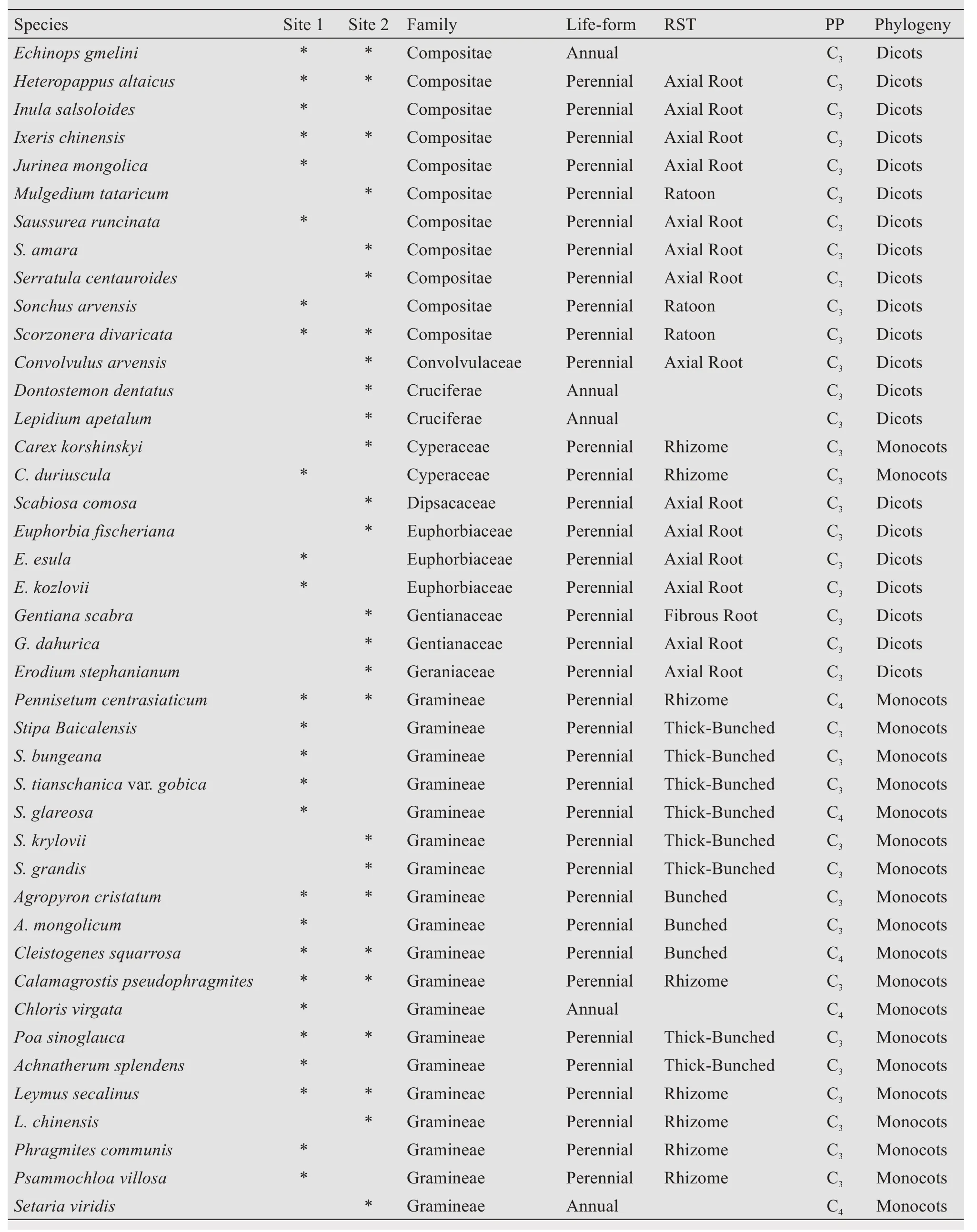
Table 2 Different functional groups of all collected plant species in the Ningxia Habahu National Nature Reserve and in Sanggendalai of Zhenglan Banner of Inner Mongolia,China
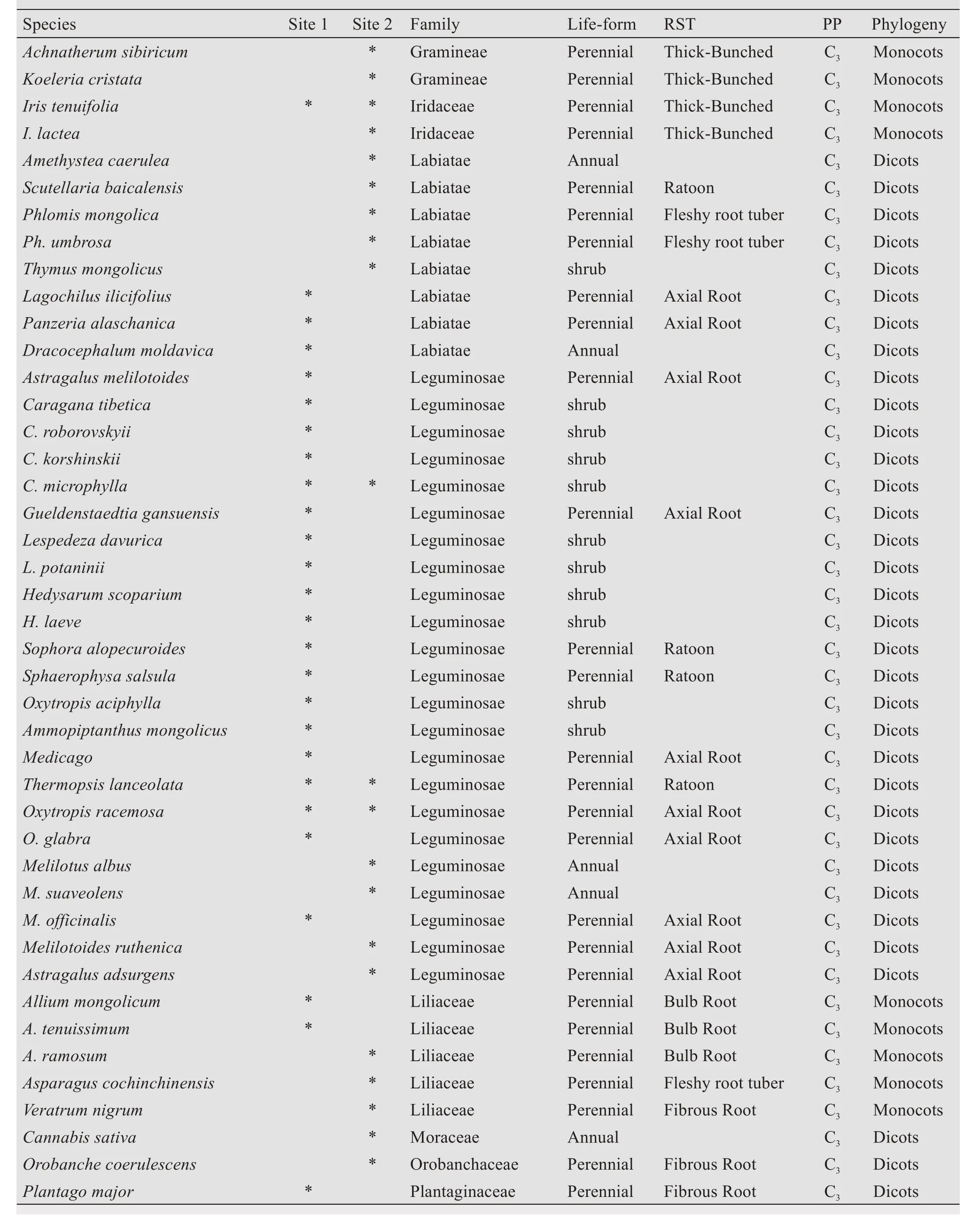
Table 2 Different functional groups of all collected plant species in the Ningxia Habahu National Nature Reserve and in Sanggendalai of Zhenglan Banner of Inner Mongolia,China
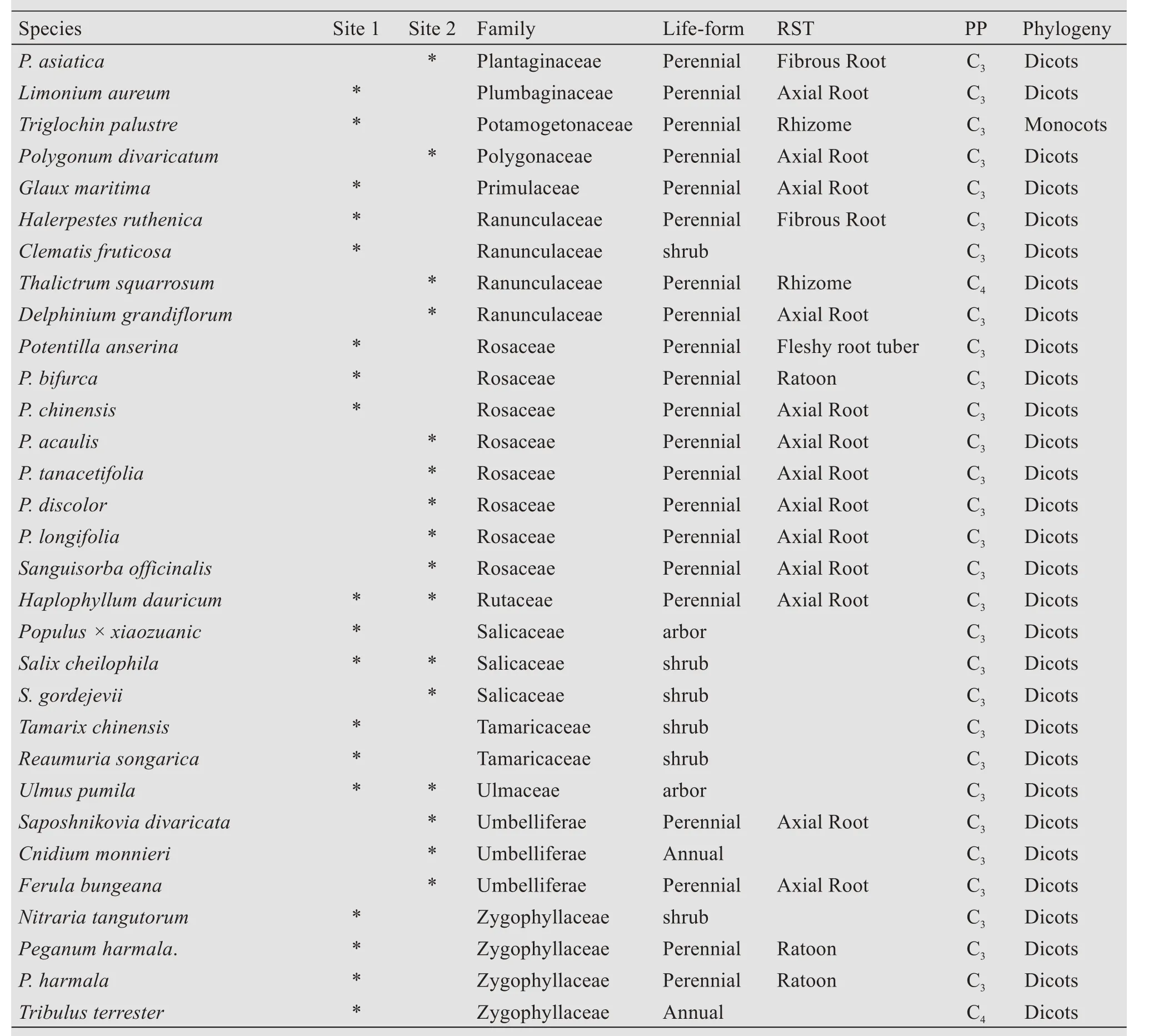
Table 2 Different functional groups of all collected plant species in the Ningxia Habahu National Nature Reserve and in Sanggendalai of Zhenglan Banner of Inner Mongolia,China
2.3 Statistical analyses
As to plant functional groups in this paper,growth types for all collected plants were divided into arbor,shrub,perennial and annual;the carbon metabolism pathways were divided by C3and C4(Li,1993;Tang and Liu,2001;Liet al.,2005;Suet al.,2011).Perennial herbs in the two locations were classified into rhizome,ratoon,bulb root,thick-bunched,fleshy root tuber,bunched,fibrous root and axial root(Chen,1987;Wang and Chen,2003);and phylogenetic types were classified into monocotyledon and dicotyledon plants.
SPSS 20.0 software was used for one-way ANOVA to compare the differences of N/P ratios among different functional groups in each type of steppe.Then,independent samplet-test was used to test the differences of N/P ratios in the same functional group of the two vegetation zones.
3 Results
3.1 N/P ratio of plants in different photosynthetic pathways
Statistical analysis shows that the N/P ratios of C3plants in desertified steppe were significantly higher than those in typical steppe(P<0.05),but no significant difference between the N/P ratios of C4plants in two types of steppe existed(P>0.05),and no significant difference between N/P ratios of C3plants and C4plants in the same type of steppe(P>0.05;Figure 1).
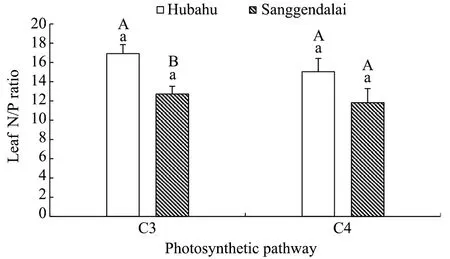
Figure 1 Comparisons between plant N/P ratios of different photosynthetic pathways in the Habahu National Nature Reserve of Ningxia and in Sanggendalai of Zhenglan Banner in Inner Mongolia(The capital letter indicates the difference between same variable of both places.The lower-case letter indicates the difference between/among different variables for same places)
3.2 N/P ratio of plants with different phylogenetic types
According to different phylogenetic types,results show that there was no significant difference in N/P ratios between dicotyledons and monocotyledons in the same steppe(P>0.05);but comparing the same phylogenetic types of plants in desertified steppe and typical steppe,we see that the N/P ratio of dicotyledons in desertified steppe was significantly higher than those in typical steppe(P<0.05),while there existed no such difference between N/P ratios of monocotyledons in two types of steppe(P>0.05;Figure 2).
3.3 N/P ratio of gramineous and non-gramineous plants
Statistical results show that the N/P ratio of gramineous plants was significantly higher than that of non-gramineous plants in the typical steppe of Sanggendalai(P<0.05),while there was no significant difference in N/P ratio between gramineous and non-gramineous plants in the desertified steppe of Habahu(P>0.05);there existed no significant differences in N/P ratios of gramineous plants between two types of steppe as well as non-gramineous plants(P>0.05;Figure 3).Comparing N and P contention of gramineous and non-gramineous plants in Sanggendalai,it can be seen that the leaf N contention of gramineous plants was significantly higher than of non-gramineous plants(P<0.05),and the leaf P contention of gramineous plants equals to non-gramineous plants in typical steppe(P>0.05;Figure 4).

Figure 2 Comparisons of N/P ratio between monocotyledon and dicotyledon plants in the Habahu National Nature Reserve of Ningxia and in Sanggendalai of Zhenglan Banner of Inner Mongolia(The capital letters indicates the difference between same variable of both places.The lower-case letter indicates the difference between/among different variables for same places)

Figure 3 Comparisons of N/P ratio between Gramineous and non-Gramineous plants in the Habahu National Nature Reserve of Ningxia and in Sanggendalai of Zhenglan Banner of Inner Mongolia

Figure 4 Comparisons of N and P contention of gramineous and non-gramineous plants in Sanggendalai of Zhenglan Banner of Inner Mongolia
3.4 N/P ratio of different root types of perennial herbs
In this study,perennial herbs were counted according to different root types,the results show that,for perennial herbs,there existed no significant differences in N/P ratios among eight different root types of plants in the same steppe and between the N/P ratios of the same root types of plants in two types of steppe(P>0.05;Figure 5).

Figure 5 Comparisons of N/P ratios between different root types of plants in the Habahu National Nature Reserve of Ningxia and in Sanggendalai of Zhenglan Banner of Inner Mongolia(In the abscissa,RhT,RaT,BRT,TBT,FlRT,BT,FiRT and ART representRhizome,Ratoon,Bulb Root,Thick-Bunched,Fleshy Root Tuber,Bunched,Fibrous Root and Axial Root types,respectively)
4 Discussion
4.1 Characteristics of N/P ratio of plants in different photosynthetic pathways
Comparing the N/P ratio of plants with the same carbon metabolism pathway in two types of steppe,it was found that the N/P ratios of both C3and C4plants in the desertified steppe of the Habahu Nature Reserve were higher than those in the typical steppe of Sanggendalai,but the difference was significant for the N/P ratios of C3plants but not for those of C4plants. The higher plant N/P ratio means slower growth for plants(Guoet al.,2018).The higher N/P ratio of C3plants in the desertified steppe of the Habahu Nature Reserve accorded with climate conditions.Rainfall in the Habahu Nature Reserve was less than that in Sanggendalai,and the high N/P ratio of plants in the Habahu Nature Reserve reveal the special metabolic mechanism of desertified steppe plants in response to drought and heat stress.Plants need large amounts of P-rich RNA to meet normal growth under drought conditions,but at the same time,these plants urgently need higher N allocation to enhance their resistance to a drought environment(Lan and Zhang,2008;Taoet al.,2016),therefore,the allocation of N was higher than that of P for desertified steppe plants.In addition,soil in the Habahu Nature Reserve contained a high CaCO3content(Youet al.,2016),high CaCO3concentration could significantly reduce the availability of soil phosphorus(Lianget al.,2018).Thus,plants in the Habahu Nature Reserve had a higher plant N/P ratio.In the present study,there was no significant difference in N/P ratio between C3and C4plants in the same type of steppe,which is consistent with the results of Songet al.(2012),Zhanget al.(2014b)and Taoet al.(2016).Previous studies have shown that the N and P contents of C3plants were generally higher than those of C4plants,therefore,C4plants have more advantages in growth and development than C3plants under the environment of N and P nutrient restriction(Zhanget al.,2010;Liuet al.,2012;Ajaoet al.,2017),but Güsewell(2004)believed that the advantage given to C4plants by the photosynthetic pathway might not be related to the restriction of N or P.Combined with the result that there was no significant difference in the N/P ratio between C3and C4plants in this study,the N/P ratio stoichiometric characteristics between different photosynthetic pathways needs further study.
4.2 Stoichiometric characteristics of N/P ratio of plants in different phylogenetic types
In the present study,the N/P ratio of dicotyledons in the desertified steppe of the Habahu Nature Reserve was significantly higher than that in the typical steppe of Sanggendalai.Comparing the geo-climatic factors between the two places,it was found that temperature and precipitation were quite different under two different types of steppe.Rainfall in the Habahu Nature Reserve(296.5 mm)was less than that in Sanggendalai(370.7 mm),while the annual average temperature of Sanggendalai(1.5°C)was much lower than that of the Habahu Nature Reserve(7.7°C).Previous studies on the trend of N/P stoichiometric characteristics of plant leaves with climatic factors at different regional scales show that the N/P ratio of leaves was positively correlated with temperature(Reich and Oleksyn,2004;Hanet al.,2005)and negatively correlated with precipitation(Zheng,2006;Liet al.,2010),which is consistent with the results of this study and reveal the adaptive mechanism of dicotyledonous plants with environmental changes.In addition,among the species investigated in this study,the proportion of leguminous plants in the Habahu Nature Reserve (26.8%) was much higher than that in Sanggendalai(11.3%),and the nitrogen fixation characteristics of leguminous plants also had an impact on the N/P ratio of dicotyledonous plants in both places.Because only a few monocotyledons were found in both type of steppe,which were not dominate,the changing trend of N/P ratios of monocotyledons in both places was not obvious as those of dicotyledons,which is also the focus of our follow-up research.For plants of different phylogenetic types,previous studies show that there was no significant difference in N/P ratio between monocotyledons and dicotyledons(Renet al.,2007;Taoet al.,2016).The results of this study also shows that there exist no significant difference in N/P ratio between dicotyledonous and monocotyledonous plants in the same type of steppe.Previous studies have found that the N/P ratio stoichiometric characteristic of functional groups are related to phylogenetic relationships, the closer the relationships are, the smaller the differences in N and P contents will be(Renet al.,2007;Liuet al.,2012;Penget al.,2017).
4.3 Stoichiometric characteristics of N/P of gramineous and non-gramineous plants
In the present study,gramineous plants had higher N/P ratios than that of non-gramineous plants in typical steppe of Sanggendalai of Zhenglan Banner of Inner Mongolia.Gramineous plants are the main dominant plants in Sanggendalai,their roots located in the upper layer of soil,and most of the roots are fibrous,thus their competition for water and nutrient elements is always in the dominant position in the community under increased rainfall(Donget al.,2016),therefore,gramineous plants in the typical steppe have stronger ability to compete for nitrogen and phosphorus elements than other plants.Most gramineous plants,such asS.kryloviiandS.grandis,are main construction species in the typical steppe,after eaten by herbivores,the presence of basal tillers,internode basal and leaf basal mesenchymal tissues make the stalks and leaves regenerate rapidly(Shenet al.,2013),the demand for N and P elements increases synchronously.Several studies have shown that gramineous plants are more sensitive to N than other plants,nitrogen application can promote the above-ground growth of gramineous plants(Sunet al.,2018;Yu and Wu,2018).However,insufficient P uptake in the soil by plants is due to relatively low P concentration in our study area,and the slow turnover of P causes a relatively high N/P ratio of gramineous plants,which also indicates that P may be a greater limiting factor for gramineous plants than N.For desertified steppe of Habahu,where gramineous plants do not occupy the dominant position in the communities,the difference of N/P ratio between gramineous and non-gramineous plants is not significant.It can be seen that plants will adjust their distribution patterns(Fanet al.,2010)in response to environmental changes,and also form a unique stoichiometric feature for long-term adaptation to the environment.
4.4 Stoichiometric characteristics of N/P ratio in different root types of perennial herbs
Due to the difficulty of identifying plant roots,previous studies have paid less attention to the stoichiometric characteristics of plant roots(Xuet al.,2010),and generally focused on the comparison of N and P stoichiometric characteristics between roots and other plant organs.For example,related studies have found that the N/P ratio of plant roots is basically similar to that of leaves,indicating the conservative characteristics of element stoichiometric ratios in plants,it also shows that the distribution of nutrients aboveand below-ground is relatively balanced(Wuet al.,2011;Yuanet al.,2011;Ninget al.,2017).The analysis of N and P characteristics of roots of 120 plant species in a Chinese grassland transect shows that N/P ratio variation is the smallest compared with C/N ratio and C/P ratio,indicating that plant roots tended to have the same N/P(Fanet al.,2014).At present,there are few studies on systematic classification of plant roots on a large scale,so little is known about the N/P ratio stoichiometric variation of plants with different root types.In this study,there existed no significant differences in N/P ratios among eight different root types in the same steppe as well as the N/P ratios of same root types between two types of steppe,which shows that different root types had relatively little effect on the N/P stoichiometric characteristics of plant leaves.
5 Conclusions
For different plant functional groups,the N/P ratios of C3plants and dicotyledonous plants in the desertified steppe are significantly higher than those in the typical steppe;gramineous plants has a higher N/P ratio compared with non-gramineous plants in the typical steppe,but not in the desertified steppe.Plant N/P ratio stoichiometric characteristics indicates their internal competition mechanism.The similarity of plant N/P ratios of different functional groups in the same type of steppe is the result of convergence and adaptation to the same environment,while the difference between plant N/P ratio of the same functional group in the two different types of steppe reveals the adaptive strategies adopted by plants for environmental difference.
Acknowledgments:
This research was supported by the National Key Research and Development Program of China(2016YFC0500706).
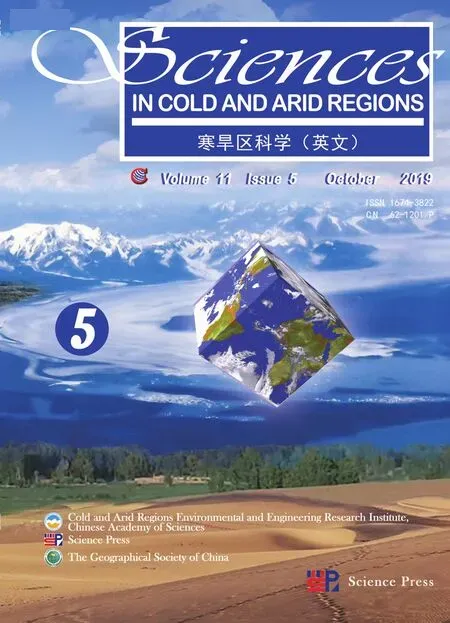 Sciences in Cold and Arid Regions2019年5期
Sciences in Cold and Arid Regions2019年5期
- Sciences in Cold and Arid Regions的其它文章
- Editors-in-Chief Guodong Cheng and Ximing Cai
- Origin and advances in implementing blowing-snow effects in the Community Land Model
- Analysis of chaotic climatic process in the Tarim River Basin(I)
- Seed germination and seedling growth of Pycnanthus angolensis(Welw.)Warb.,African false nutmeg
- Soil hydraulic conductivity and its influence on soil moisture simulations in the source region of the Yellow River―take Maqu as an example
- Qualitative and quantitative phytochemical analysis of selected mosses with different alcoholic solvents
